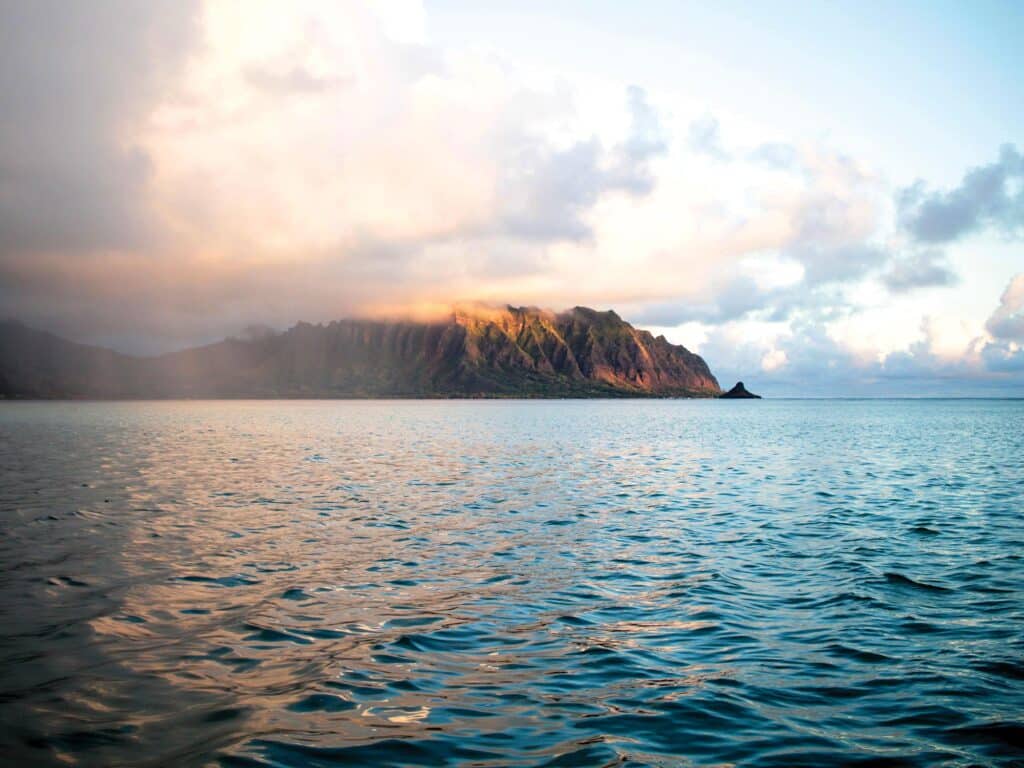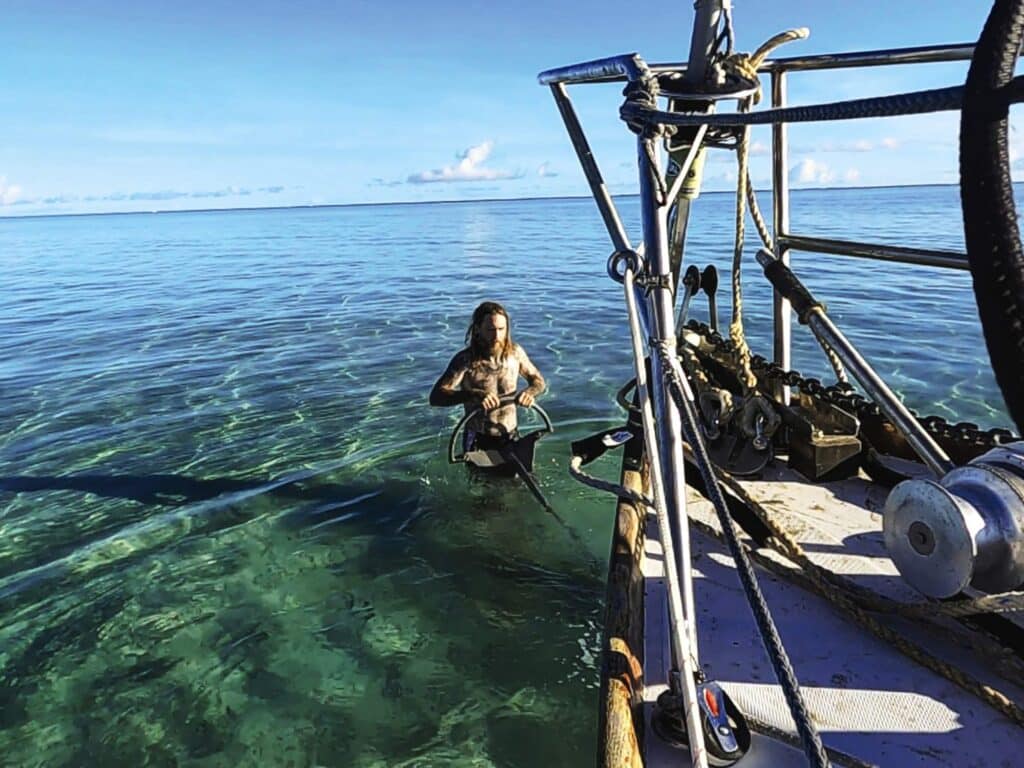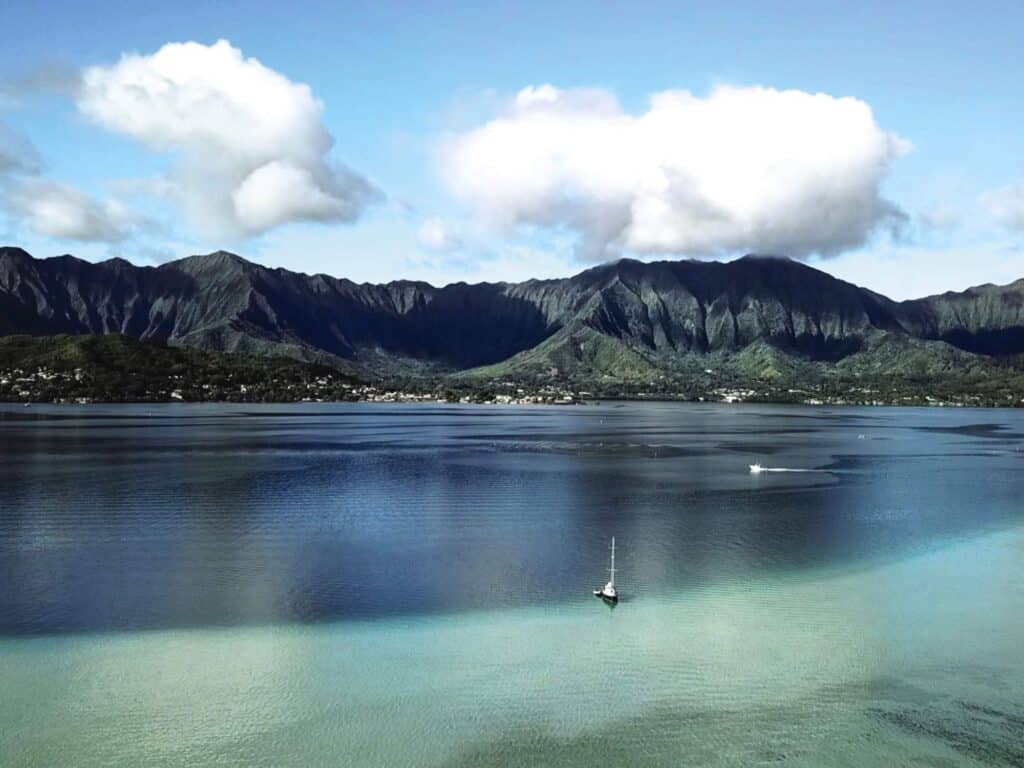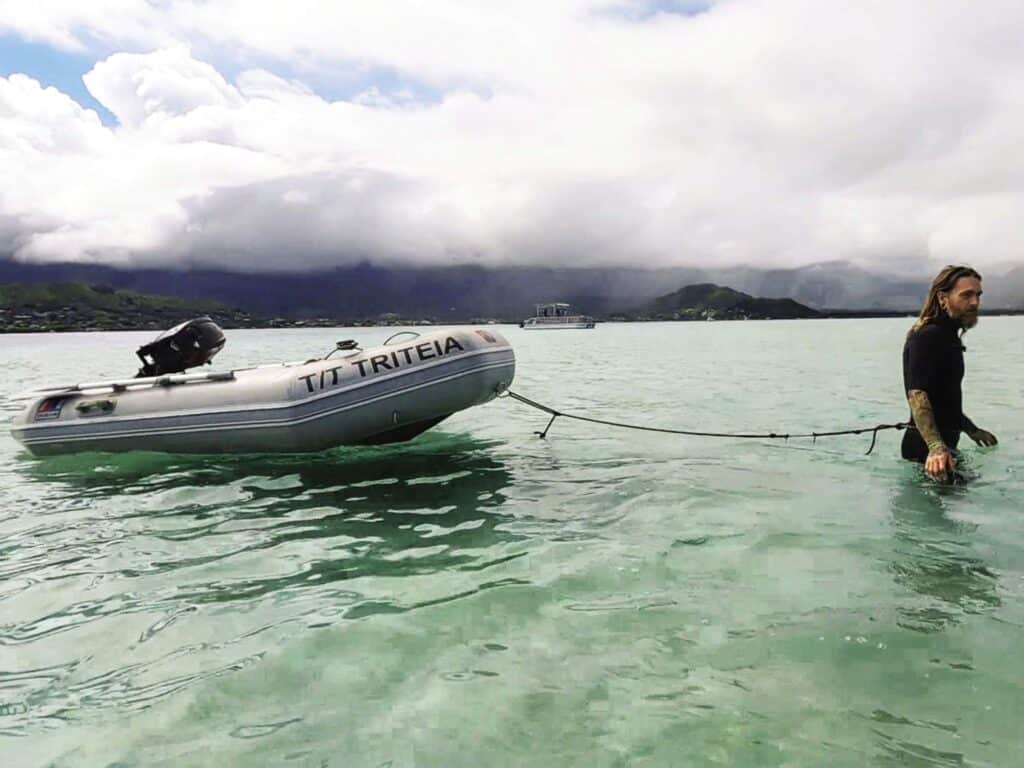
I could smell the forest before I even opened my eyes. It was a sweet, woodsy smell with a heavy fragrance of wet earth. If I kept my eyes closed, I could easily have placed myself on the forest floor, surrounded by the refuse of the trees that were making their way to becoming soil.
When I did open my eyes, I remembered that I was lying under anchor on board Triteia, my 1965 Alberg 30 sloop, in Kaneohe Bay, on the windward side of the Hawaiian island of Oahu. I climbed out of my berth and started my morning routine: filled the kettle, lit the fire, and loaded up my stainless-steel French press with ground coffee. Out on deck, I looked toward the sea, and then toward land. The boat gently swayed as I made my way forward and took in the scents until I heard the kettle boiling. I poured the hot water over the coffee grounds. This morning was an olfactory bonanza.
At dawn, Oahu’s Ko’olau Range was bathed in golden light. We were anchored 400 yards from the He’eia loko i’a, a traditional Hawaiian fishpond estimated to be more than 800 years old. These fishponds are used for aquaculture of fish, taro and algae, and were an important part of supplying the Hawaiian people with food. In the late 18th century, they were producing 2 million pounds of fish per year.
That day, Triteia was bound for a new anchorage in a different part of the bay. Our destination was the Kaneohe Sandbar, a popular spot for locals and tourists alike. The sandbar is about a mile wide and 3 miles long, and spends most of its time submerged. The unique shape, with steep underwater faces, allows larger sailboats to anchor mere feet from the shallows.

After I weighed anchor, I motored Triteia out through a calm mooring field. As far as I could see in the bay, the water was as still as a lake, but the charts showed the bay littered with large, coral bommies. They might as well be landmines sitting just below the surface. Private citizens had installed small, white pipes into the reefs’ outer edges that flank the dredged channel; I kept an eye on my navigation app and located a clear path that would take us to the spot on the sandbar where I planned to anchor for the next three nights.
A fellow cruising sailor here in Hawaii, Cy Henry, had explained the process of anchoring in this peculiar location: “You will want to motor in very slowly, watching your depths on the depth sounder. When you see the depths dropping rapidly, just wait for the bump as your hull hits the bar. Run forward, let go your anchor, and pay out about 10 feet of chain. Then, back up the boat to slightly set the anchor. Next, pay out more chain, swim ashore, and carry your anchor into the shallows however far you like.”
This is a good time to mention the fact that I am doing all of this alone. Cy said that I might want to use a second anchor to hold the boat in place while moving the primary anchor. This would be necessary only if the trades were blowing. Normally, the windward side of Oahu, which faces east-northeast, experiences these winds.

I had planned my visit to coincide with a rare slackening of the trade winds, and I was pleased to see that the forecast was accurate, with only a light offshore breeze. If I were to attempt to anchor with the trade winds blowing, my boat could easily get away from me and blow out into the bay, bound for coral reefs and, eventually, the shore as I stood waving goodbye from the shallow sandbar.
As I motored slowly, I thought how truly strange it was to be driving toward a submerged beach with the intention of running into the sand. A disconcerting clue to the depth, aside from instrumentation, was the rapid change in the water’s color. It shifted from cobalt blue to a brilliant turquoise as the sun reflected off the white sand below.
Soon, I felt the bump of my hull on the soft sandbar. I hurried forward, let go my 45-pound anchor, and paid out some 10 feet of chain. I then reversed the boat to set it. I let out more chain and, for the first time in my life, jumped off the bow of my boat into 2 feet of water. I lifted up the anchor and carried it back some 20 feet to give it more scope.
As I was pushing my anchor in the sand, a paddleboarder casually cruised past me. I stood near where the water depth dropped from 2 feet to 20 feet in less than the length of my boat, climbed back on board Triteia, and deployed a second anchor off the stern. The steep drop-off meant that there was no risk of going aground, but the offshore breeze and changing tides could cause the boat to bump in the night.
As the day progressed, the sun heated the forests and the mountain range created its own clouds. With the absence of the trade winds, these clouds increased in size until they shrouded the mountaintops. I watched this happen day after day, realizing how rare it is to be able to slow down one’s life to the point of having the opportunity to watch clouds be built.

As the sun marched on, boats of all shapes and sizes arrived at the sandbar: sailboats, motorboats, pontoons, kayaks, paddleboards. At one end of the sandbar, I could see a volleyball net near a tour boat. Where the sandbar meets the ocean, some 20-plus kayaks explored just inside gentle waves breaking on the reefs. To the south, fishing boats and pleasure craft spread out, with families swimming and walking in the warm water. Next to Triteia, a small powerboat arrived with a mother and her adult daughter as captain and crew. They blew up classic, colorful pool floaties, walked a few yards, sat in them and opened two beers. In all, I counted 50 boats, and everyone had as much space as they wanted.
As the afternoon progressed, the clouds obscured the sun. The islanders hauled up and made their way back to the shore. Triteia had the sandbar all to itself. I sat in the cockpit as gentle rains passed from north to south down the bay. The sunset broke through a few gaps, with beautiful golden rays shifting in remarkable contrast to the dark gray clouds and green mountainsides. The water’s surface was still and slick, with Hawaiian sea turtles popping their small, round heads up for air.
As night arrived, I ate dinner in the cockpit and enjoyed the quiet. Looking in any direction, it would appear we were well offshore, but we were anchored in one of the calmest spots I’d ever had the pleasure of experiencing.
Turning in for the night, I climbed into my bunk and opened my forward hatch. I looked up at the twinkling stars between gaps in the clouds. The anchorage was completely silent as a gentle onshore breeze blew in through the hatch and brought with it the familiar scent of the sea.
Writer and filmmaker James Frederick has logged more than 10,000 nautical miles of passagemaking in his sailing career. Most recently, he completed solo ocean passages from Los Angeles to Hawaii, and Hawaii to French Polynesia. Follow Frederick’s journey on his YouTube channel.








